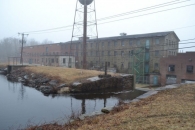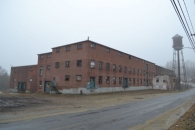Mill Record Killingly
RETURN TO ‘FIND MILLS’Disclaimer: Content for these properties was compiled in 2014-2017 from a variety of sources and is subject to change. Updates are occasionally made under Property Information, however the Connecticut Trust for Historic Preservation (dba Preservation Connecticut) makes no representation or warranty that the information is complete or up-to-date.
- Complex Name (Common)
- Acme Cotton Co.DEMO’D FIRE 3/2019
- Complex Name (Historic)
-
- Chestnut Hill Mill
- Ross Mill
- Address or Location
- 963 Bailey Hill Road, East Killingly, Killingly
- County
- Windham
- Historic Designation
- Associated Mill Community

- Historic Information
Companies Associated w/Complex
- Westcott & Pray Co. 1846-1849; 1856-1859
- John D. Burgess 1849-1856
- Mayhew Miller & Co. 1859-1869
- Thomas Pray & Co. 1869-1874
- John L. Ross Mill 1874-1899
- A.G. Bishop Mill 1899-Unknown
- Acme Cotton Products Co. 1925-ca. 1978
Use (Historic)
Largest Documented Workforce
100-199 (1939)
Historic Narrative
The original portion of the former Acme Cotton Company plant and its associated dam were erected as a cotton mill by prominent Killingly industrialists, Henry Westcott and Thomas Pray, in 1846. Known as the Chestnut Hill Mill, this plant exchanged hands numerous times in its early years. At the time of its establishment in 1846 it was owned and operated by the Westcott and Pray Company, however, it was soon acquired by Mayhew Miller and Co. of Baltimore, Maryland, which leased it back to Westcott and Pray until 1859. In 1859, management was taken over by Mayhew Miller, Jr. Miller ran the mill until 1869 when Thomas Pray bought it back and established his son, Thomas Pray, Jr. as manager. This arrangement continued until around 1874 when it was purchased by John L. Ross. During the 1860s, Thomas Pray Jr. made numerous improvements to the mill, as well as built several tenement and boarding houses in the vicinity. By 1880, Ross employed roughly 60 workers who oversaw 104 40-inch looms and 6,000 spindles turning out a weekly output of over 25,000 yards of cotton cloth per week. Ross maintained the business until 1899, at which time it passed to A. G. Bishop of New York. Bishop operated the plant for a number of years but by 1920 it had fallen silent. In 1925, the Chestnut Hill Mill was purchased by the newly-formed Acme Cotton Company. The firm was established by F.W. Buchman and Herman Schnaitlacher for the production of medical supplies and cotton bandages. The Acme Cotton Company made significant improvements to the plant during the 1930s and 1940s and although the workforce totaled 80 persons in 1932, it numbered between 100 and 199 employees throughout the late-1930s. The firm made considerable contributions to the war effort during the Second World War and secured numerous contracts to provide surgical dressings and other medical supplies to the United States Military. These efforts earned the company an Army-Navy ‘E’ Award for excellence in 1945. The Acme Cotton Company continued to occupy the former Chestnut Hill Mill into the early 1970s. In 1975, the firm announced plans to build a large suburban-style manufacturing complex along Lake Road in the Killingly Industrial Park. The plant was to comprise over 175,000 square feet and employ 350 workers. The total cost of the project was $4 million and it was completed between 1977 and 1978, whereupon the firm’s older plant was abandoned. The latter currently stands vacant.
- Architectural Information
Number of Existing Buildings
Thirteen (13) primary blocks.
Dates of Construction
1846, ca. 1925, ca. 1933, 1940, ca. 1960, ca. 1970.
Architect
n/a
Builder
n/a
Building Type
Architectural Description
The former Acme Cotton Company plant is comprised of approximately thirteen adjoining primary blocks located on the west side of Bailey Hill Road, directly south of its intersection with Bear Hill Road. The mill complex stands directly west of a 520’-long stone and earth dam, behind which Whetstone Brook fills Acme Pond, the original mill’s powersource. The plant’s millrace passes under Bailey Hill Road and the northern end of the mill via an arched brownstone culvert and after emerging west of the factory continues on a generally southwesterly course past numerous other historic mills and mill sites. The oldest portion of the Acme Cotton Company plant survives from the mill’s original construction in 1846. This is a four-story, 100’ x 40’ stone manufacturing building with a low-pitch side-gabled roof. The block is twelve bays wide and five bays deep. Its regularly-spaced window openings have heavy stone sills and non-original metal sash with hopper style openings. The building was lengthened to 140’ - likely during the early-20th century - through the construction of a brick addition at its southern end. This is of similar massing to the original block and connects it to another addition that was constructed in 1940. The latter is a three-story, 152’ x 40’ red brick block with raised concrete basement level, multi-pane metal sash, and a flat roof. Two additional blocks of similar design were also erected in 1940. These are located at the southwest corner of the complex and consists of a three-story, 141’ x 38’ red brick block; and a two-story, 148’ x 60’ red brick building. Further modifications to the plant include the construction of several blocks on the north, east, and west sides of the 1846 mill between the 1930s and 1970s. A two-story red brick shipping and storage building with a stepped parapet, a two-story stone storage block, and another two-story red brick block were all built on the north side of the original mill around 1933. These measure roughly 40’ x 180’ overall and have metal sash windows and flat roofs. A two-story, 45’ x 15’ red brick office block was built near the southeast corner of the 1846 mill around 1940. This is notable for its prominent bowfront, which houses an entry door centered between two windows on the first floor and three windows above. The remainder of the plant is comprised of several one- and three-story blocks built on the west side of the plant at unknown dates between 1934 and 1975. They are of a mix of red brick, concrete block, and steel-frame construction and have flat roofs.
Exterior Material(s)
Structural System(s)
Roof Form
Roof Material
Power Source
Condition
Fair, Deteriorated
Condition Notes
The factory is in fair to deteriorated condition with many of the walls, windows, and roofs in serious need of repair.
- Property Information
-
Specific Location
One 53.0-acre parcel (963 Bailey Hill Road) on the west side of Bailey Hill Road, directly south of its intersection with Bear Hill Road.
Adjacent To
Exterior Visible from Public Road?
Yes
Parcel ID / Assessor Record Link
- 100/66 / Link →
Acreage
53.0
Use (Present)
- Sources
-
Form Completed By
Lucas A. Karmazinas
Date
04/13/2015
Bibliography
- List of Connecticut Manufacturers, 1922, 1924, 1930, 1932.
- Directory of Connecticut State Manufacturers, 1936, 1939.
- Industrial Directory of Connecticut, 1947.
- Register of War Production Facilities in Connecticut, 1951.
- Map of Windham County, E.M. Woodford, 1855.
- Atlas of Windham County, O.W. Gray, 1869.
- Hartford Courant, 1941, 1945. 1975, 1978.
- A History of Windham County, Connecticut; Bayles, Richard M., ed., 1889.
- A Modern History of Windham County, Connecticut; Lincoln, Allen B., 1920.
- Miles of Millstreams: A Chronicle of Killingly, Connecticut; Weaver, Margaret M., 1976.
- Roth, Matthew, et al, Connecticut: An Inventory of Historic Engineering and Industrial Sites (Washington DC: SIA, 1981).
- Representative View(s)Click on image to view full file








